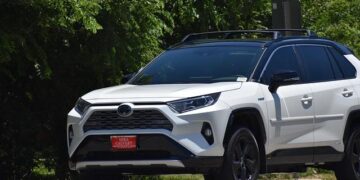Sand, salt, iron, copper, oil and lithium — these foundational materials are literally what the modern world is built on. Without sand for glass, say goodbye to our fiber optic internet. No copper means no conductive wiring. And a world without lithium is a world without rechargeable batteries.
For the final installment of Hitting the Books for 2023, we’re bringing you an excerpt from the fantastic Material World: The Six Raw Materials That Shape Modern Civilization by Ed Conway. A finalist for the Financial Times and Schroders Business Book of the Year award, Material World walks readers through the seismic impacts these six substances have had on human civilization throughout history, using a masterful mix of narrative storytelling and clear-eyed technical explanation. In the excerpt below, Conway discusses how the lithium ion battery technology that is currently powering the EV revolution came into existence.
Thanks very much for reading Hitting the Books this year, we’ll be back with more of the best excerpts from new and upcoming technology titles in post-CES January, 2024!
Penguin Random House
Excerpted from Material World: The Six Raw Materials That Shape Modern Civilization by Ed Conway. Published by Knopf. Copyright © 2023 by Ed Conway. All rights reserved.
A Better Battery
The first engineer to use lithium in a battery was none other than Thomas Edison. Having mastered the manufacture of concrete by focusing religiously on improving the recipe and systematising its production, he sought to do much the same thing with batteries. The use of these devices to store energy was not especially new even when he began working on them at the dawn of the twentieth century. Indeed, the very earliest days of the electrical era were powered almost exclusively by batteries. Back before the invention of the dynamos and generators that produce most of our electricity today, the telegraphs and earliest electric lights ran on primitive batteries.
Their chemistry went back to Alessandro Volta, an Italian who, at the turn of the nineteenth century, had discovered that by stacking layers of zinc and copper discs separated by cardboard soaked in brine, he could generate an electric current, flowing from one electrode (in this case the metallic discs) to the other. His pile of electrodes was the world’s first battery — a voltaic cell — or as it’s still sometimes called, a pile (since a pile is precisely what it was). That brings us to the prickly question of what to call these things. Purists would argue that a single one of these units, whether it was Volta’s first effort or the thing you find in your smartphone, should be called a cell. A battery, they say, is a word only to be used about an array of multiple cells. But these days most people (including this author) use the words interchangeably.
Half a century later the French physicist Gaston Planté came up with the first rechargeable battery using a spiral of lead electrodes bathed in acid, housed in a glass container. Lead-acid batteries, versions of which are still used to help start car engines today, could provide quick bursts of power, but their relatively low energy density meant they were not especially good at storing power.
In an effort to improve on the chemistry, Edison began to experiment his way through the periodic table. Out went lead and sulphuric acid and in came a host of other ingredients: copper, cobalt and cadmium to name just a few of the Cs. There were many false starts and one major patent battle along the way but eventually, after a decade of experimentation, Edison landed upon a complex mixture of nickel and iron, bathed in a potassium hydroxide solution and packed into the best Swedish steel.
“The only Storage Battery that has iron and steel in its construction and elements,” read the advertising.
Edison’s experiments underlined at least one thing. While battery chemistry was difficult, it was certainly possible to improve on Planté’s lead–acid formula. After all, as Edison once said, “If Nature had intended to use lead in batteries for powering vehicles she would not have made it so heavy.” And if lead was a heavy metal then there was no doubt about the lightest metal of all — the optimal element to go into batteries. It was there at the opposite end of the periodic table, all the way across from lead, just beneath hydrogen and helium: lithium. Edison added a sprinkling of lithium hydroxide to the electrolyte solution in his battery, the so-called A cell, and, alongside the potassium in the liquid and the nickel and iron electrodes, it had encouraging results. The lithium lifted the battery’s capacity by 10 per cent — though no one could pin down the chemistry going on beneath the surface.
In the following years, scientists followed in Edison’s footsteps and developed other battery chemistries, including nickel–cadmium and nickel–metal hydride, which are the basis for most consumer rechargeable batteries such as the AA ones you might have at home. However, they struggled to incorporate the most promising element of all. Decade after decade, scientific paper after paper pointed out that the ultimate battery would be based on a lithium chemistry. But up until the 1970s no one was able to tame this volatile substance enough to put it to use in a battery. Batteries are a form of fuel — albeit electrochemical rather than fossil. What occurs inside a battery is a controlled chemical reaction, an effort to channel the explosive energy contained in these materials and turn that into an electric current. And no ingredient was more explosive than lithium.
The first breakthrough came in the 1970s at, of all places, Exxon-Mobil, or as it was then known, Esso. In the face of the oil price shock, for a period the oil giant had one of the best-funded battery units anywhere, staffed by some of the world’s most talented chemists trying to map out the company’s future in a world without hydrocarbons. Among them was a softly spoken Englishman called Stan Whittingham. Soon enough Whittingham had one of those Eureka moments that changed the battery world forever.
Up until then, one of the main problems facing battery makers was that every time they charged or discharged their batteries it could change the chemical structure of their electrodes irreversibly. Edison had spent years attempting to surmount this phenomenon, whose practical consequence was that batteries simply didn’t last all that long. Whittingham worked out how to overcome this, shuttling lithium atoms from one electrode to the other without causing much damage.
At the risk of causing any battery chemists reading this to wince, here is one helpful way of visualising this. Think of batteries as containing a set of two skyscrapers, one of which is an office block and the other is an apartment block. These towers represent the anode and cathode — the negative and positive electrodes. When a rechargeable smartphone or electric car battery is empty, what that means in electrochemical terms is that there are a lot of lithium atoms sitting in the cathode — in the apartment block — doing very little.
But when that battery gets charged, those atoms (or, as they’re technically called, since they hold a charge, ions) shuttle across to the other skyscraper — the anode or, in this analogy, the office block. They go to work. And a fully charged battery is one where the anode’s structure is chock-full of these charged lithium ions. When that battery is being used, the ions are shuttling back home to the apartment block, generating a current along the way.
Understand this shuttling to and fro between cathode and anode and you understand broadly how rechargeable batteries work. This concept — the notion that ions could travel across from the crystalline structure of one electrode to nest in the crystalline structure of another — was Whittingham’s brainwave. He called it intercalation, and it’s still the basis of how batteries work today. Whittingham put the theory to work and created the world’s first rechargeable lithium battery. It was only a small thing — a coin-sized battery designed for use in watches — but it was a start. Per kilogram of weight (or rather, given its size, per gram), his battery could hold as much as 15 times the electrical charge of a lead–acid battery. But every time Whittingham tried to make a battery any bigger than a small coin cell, it would burst into flames. In an effort to tame the inherent reactivity of lithium, he had alloyed it with aluminium, but this wasn’t enough to subdue it altogether. So Whittingham’s battery remained something of a curio until the following decade, when researchers working in the UK and Japan finally cracked the code.
The key figure here is an extraordinary man called John B. Goodenough, an American physicist who, as it happens, was born in Jena, the German city where Otto Schott and Carl Zeiss first perfected technical glassmaking. After studying at Yale, Chicago and the Massachusetts Institute of Technology, Goodenough eventually found himself in charge of the inorganic chemistry lab at the University of Oxford in the late 1970s and early 1980s, where he played the pivotal role in the battery breakthrough. Among his team’s achievements — commemorated today in a blue plaque on the outside of the lab — was the discovery of the optimal recipe for the cathode (that apartment skyscraper) in a lithium-ion battery. The material in question was lithium cobalt oxide, a compound that improved the safety and the capacity of these batteries, providing them with a stable cathode matrix in which the lithium ions could nest. It wasn’t that battery explosions could be ruled out, but at least they were no longer inevitable.
The final intellectual leaps occurred a few years later in Japan, where a researcher called Akira Yoshino perfected the other ingredients. He paired Goodenough’s lithium cobalt oxide cathode with an anode made from a particular type of graphite — that very variety they still make from the needle coke produced at the Humber Refinery — and the combination worked brilliantly. Lithium ions shuttled safely and smoothly from one side to another as he charged and discharged the battery. He also worked out the best way to fit these two electrodes together: by pasting the materials on to paper-thin sheets and coiling them together in a metal canister, separated by a thin membrane. This final masterstroke — which meant that if the battery began to overheat the separator would melt, helping to prevent any explosion — also evoked those first cells created in France by Gaston Planté. The rechargeable battery began life as a spiral of metal compressed into a canister; after more than a century of experimentation and a complete transformation of materials, it came of age in more or less the same form.
But it would take another few years for these batteries to find their way into consumers’ hands, and it would happen a long way from either Esso’s laboratories or Oxford’s chemistry labs. Japanese electronics firm Sony had been on the lookout for a better battery to power its camcorders, and came across the blueprints drawn up by Goodenough and adjusted by Yoshino. Adapting these plans and adding its own flourishes, in 1992 it created the first production lithium-ion battery: an optional power pack for some of their Handycam models. These packs were a third smaller and lighter than the standard nickel–metal hydride batteries, yet they carried even more capacity. In the following years, lithium-ion batteries gradually proliferated into all sorts of devices, but it wasn’t until the advent of the smartphone that they found their first true calling. These devices, with their circuitry, their semiconductors, their modem chips and bright displays, are incredibly power hungry, demanding the most powerful of all batteries. Today, almost all smartphones run on batteries derived from the discoveries of Whittingham, Goodenough and Yoshino. The trio was awarded the Nobel Prize in Chemistry in 2019.
That this invention — first prototyped in America and then mostly developed in England — only came to be mass produced in Japan is one of those topics that still causes frustration in the Anglophone world. Why, when so many of the intellectual advances in battery design happened in Europe and the Americas, was production always dominated by Asia? The short answer was that Japan had a burgeoning market for the manufacture of the very electronic goods — initially video cameras and Walkmans — that needed higher-density batteries.
As the 1990s gave way to the 2000s, lithium-ion batteries became an essential component of the electronic world, in laptops, smartphones and, eventually, electric cars. Smartphones could not have happened without the extraordinary silicon chips inside, powering the circuitry, housing the processing units and bestowing memory storage, not to mention providing optical sensors for the camera. But none of these appliances would have been practical without light, powerful batteries of far greater energy density than their predecessors.
All of which is why demand for lithium has begun to outstrip our ability to extract it from the earth. And unlike copper or iron, which we have many centuries’ experience producing, the lithium industry remains in its infancy. Up until recently there were few mines and the pools in the Salar de Atacama were still relatively small. Today they are big enough to be easily visible from space, a gigantic pastel paint palette smack bang in the middle of the desert.
This article contains affilate links; if you click such a link and make a purchase, we may earn a commission.
>>> Read full article>>>
Copyright for syndicated content belongs to the linked Source : Engadget – https://www.engadget.com/hitting-the-books-material-world-ed-conway-knopf-153010572.html?src=rss































